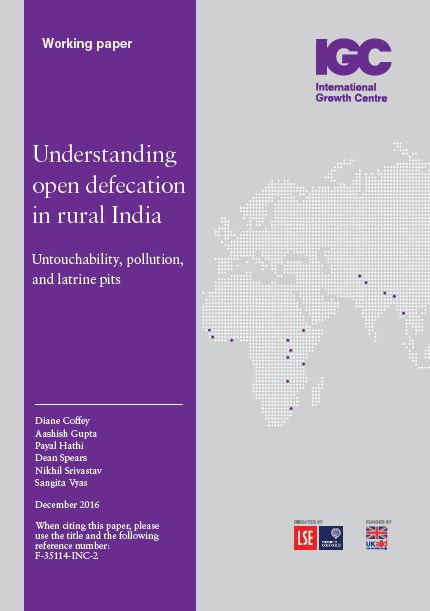Understanding open defecation in rural India. Untouchability, pollution, and latrine pits
 |
report Dec 2016 ; 20 pages
Aut. Dean Spears &
Ed. IGC -
Downloadable format: PdF
Downloadable from the publisher
Abstract:
Open defecation in rural India presents a puzzle: India has far higher open defecation rates than other developing regions where people are poorer, literacy rates are lower, and water is more scarce. Because open defecation has terrible consequences for health, it is important to understand why few villagers use latrines. This paper draws on new data to present social and cultural explanations for India’s uniquely high rates of open defecation. We find that beliefs, values, and norms about purity and pollution contribute to the ubiquity and social acceptability of open defecation. More importantly, the renegotiation of caste and untouchability discourages people from using the affordable pit latrines that are promoted by the WHO and subsidized by the Indian government. Because these latrines require manual pit emptying, and because rural Indians equate manual latrine pit emptying with manual scavenging and degrading forms of labour traditionally done by dalits, the vast majority of people do not want to use an affordable pit latrine. Rural Indians use latrines with expensive pits that are either
emptied by machine or never emptied, or they defecate in the open.
Target Audiences:
Keywords: |
access to sanitation (CI) (DT) (ET) (ope) , excreta (CI) (DT) (ET) (ope) , pollution (CI) (DT) (ET) (ope) , poverty (CI) (DT) (ET) (ope) , rural (CI) (DT) (ET) (ope) , social development (CI) (DT) (ET) (ope) , socio-economic analysis (CI) (DT) (ET) (ope) , toilets, latrine (CI) (DT) (ET) (ope) |
Country: |
Publisher/Broadcaster: |
|
IGC
-
International Growth Centre - - United Kingdom |
If there is a broken link, we will be pleased to receive a message: communication@pseau.org